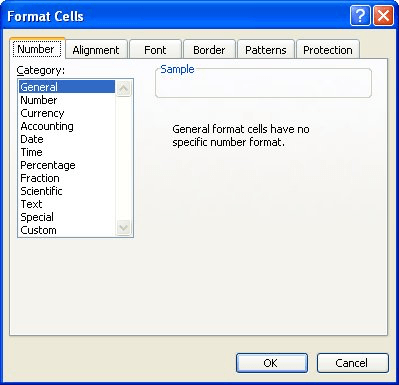Please Note: This article is written for users of the following Microsoft Excel versions: 97, 2000, 2002, and 2003. If you are using a later version (Excel 2007 or later), this tip may not work for you. For a version of this tip written specifically for later versions of Excel, click here: Converting From Numbers to Text.
Written by Allen Wyatt (last updated August 30, 2025)
This tip applies to Excel 97, 2000, 2002, and 2003
Jocelyn asked if there is a way to easily convert numbers to their text equivalent. For instance, to convert the numeric value 6789 to the text digits "6789."
There are multiple ways that you can approach this problem. One way is to simply specify to Excel that the cells should be treated as text. Display the Format Cells dialog box and then on the Number tab make sure that Text is selected. Any selected cells are then formatted as if they were text, and are moved to the left side of their cells (unless you have some other alignment format specified).
The applicability of this solution, however, depends on the version of Excel you are using. In some versions it will work as described here, but in others it may not. There is another thing you can try, however:

Figure 1. The Number tab of the Format Cells dialog box.
Another thing you can do is to use the TEXT worksheet function. Let's say you have the value 6789 in cell A7. In cell B7 you could place the following:
=TEXT(A1, "#,##0.00")
This usage of TEXT results in a text digits that have the thousands separator in the right place and two digits to the right of the decimal point, as in "6,789.00". You can specify, as the second parameter to TEXT, any formatting desired. If you want the number converted to text without any special formatting, you can use the following:
=TEXT(A1, "0")
The result is the textual equivalent of an integer value.
ExcelTips is your source for cost-effective Microsoft Excel training. This tip (2680) applies to Microsoft Excel 97, 2000, 2002, and 2003. You can find a version of this tip for the ribbon interface of Excel (Excel 2007 and later) here: Converting From Numbers to Text.

Create Custom Apps with VBA! Discover how to extend the capabilities of Office 365 applications with VBA programming. Written in clear terms and understandable language, the book includes systematic tutorials and contains both intermediate and advanced content for experienced VB developers. Designed to be comprehensive, the book addresses not just one Office application, but the entire Office suite. Check out Mastering VBA for Microsoft Office 365 today!
Getting rid of formatting from a cell or group of cells can be done using several different techniques. This tip ...
Discover MoreHave you ever been using a workbook, only to open it one day and find that Excel has changed the height of your rows or ...
Discover MoreWhen working with very large numbers in a worksheet, you may want the numbers to appear in a shortened notation, with an ...
Discover MoreFREE SERVICE: Get tips like this every week in ExcelTips, a free productivity newsletter. Enter your address and click "Subscribe."
There are currently no comments for this tip. (Be the first to leave your comment—just use the simple form above!)
Got a version of Excel that uses the menu interface (Excel 97, Excel 2000, Excel 2002, or Excel 2003)? This site is for you! If you use a later version of Excel, visit our ExcelTips site focusing on the ribbon interface.
FREE SERVICE: Get tips like this every week in ExcelTips, a free productivity newsletter. Enter your address and click "Subscribe."
Copyright © 2025 Sharon Parq Associates, Inc.
Comments